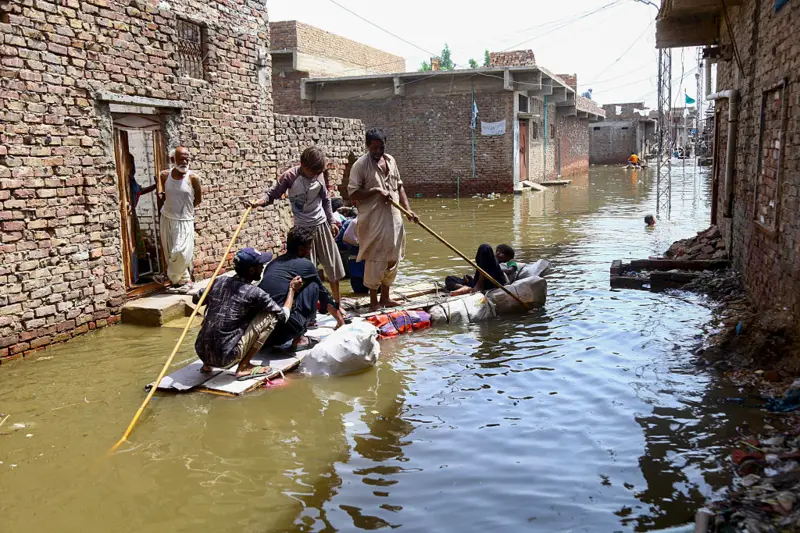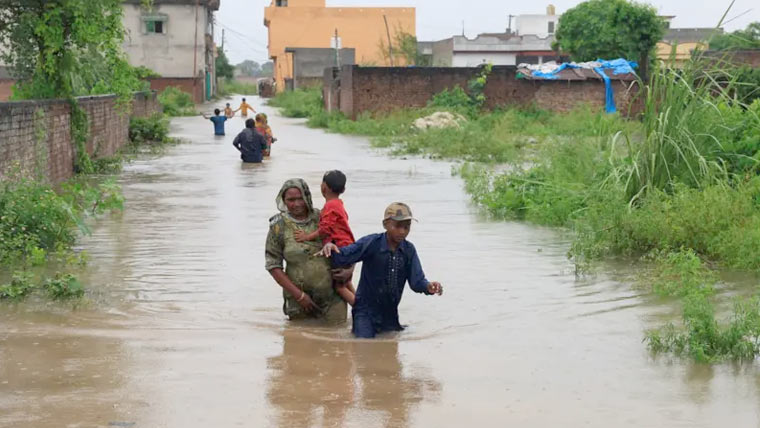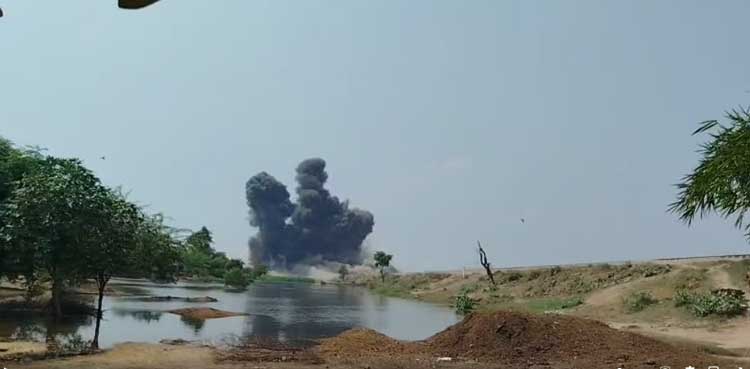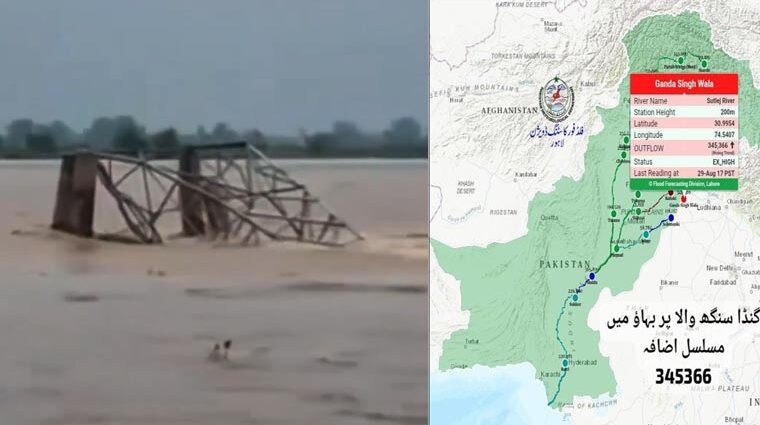Floods Wreak Havoc in Punjab: 1,769 Villages Submerged, 1.4 Million People Affected, Crops Destroyed, 28 Dead.
PDMA Punjab, to save Jhang city from flooding in the Chenab River, a breach was made near Rewas Bridge.
Lahore (Web News):
Due to the release of water from India and heavy rains, the Ravi, Chenab, and Sutlej rivers have overflowed, causing widespread devastation across Punjab. More than 1,470 villages in several districts have been submerged, 1.4 million people have been affected, standing crops have been destroyed, livestock swept away, and 28 people have lost their lives. According to PDMA Punjab, to save Jhang city from flooding in the Chenab River, a breach was made near Rewas Bridge. Relief Commissioner Punjab Nabeel Javed stated that evacuation of residents from the riverbed of Chenab has been ensured. The administrations of Faisalabad and Jhang have been placed on high alert, with all officers directed to remain in the field.
On the other hand, the overflowing Ravi River has inundated several villages around Lahore, and floodwaters have entered some suburban areas as well. Safe evacuation has been completed from Theme Park, Mohlanwal, Muridwal, Farukhabad, Shafiqabad, Afghan Colony, New Meter City, and Chuhng area. Rescue and relief operations are in full swing in Talat Park and Babu Sabu.
In Park View Housing Society, water entered four blocks, but residents were evacuated in time. At the Lachi Wali School relief camp, over 70 people have taken shelter. Most of the displaced are staying in Chuhng and Thokar relief camps, where proper food and accommodation facilities have been arranged.

According to PDMA Punjab, a massive flood wave in the Chenab River is moving towards Chiniot, Jhang, and Trimmu. At Marala, the river flow was recorded at 116,000 cusecs; at Khanki Headworks, 184,000 cusecs; and at Qadirabad, 185,000 cusecs. At Chiniot Bridge, a major flood wave is passing through, with the water flow at 855,000 cusecs.
At Head Trimmu, the water flow has reached 129,000 cusecs and is continuously rising. At River Ravi near Jassar, the flow is 84,000 cusecs. At Shahdara, the water flow is 184,000 cusecs, but it is decreasing. At Balloki Headworks, the flow is 164,000 cusecs and rising. At Ravi Head Sidhnai, the flow is 29,000 cusecs. In the Sutlej River at Ganda Singh Wala, the flow is 303,000 cusecs and increasing. At Sulemanki, the flow stands at 118,000 cusecs.
Director General of the Provincial Disaster Management Authority (PDMA), Irfan Ali Kathia, stated that the flood wave of 220,000 cusecs that passed through Shahdara in Lahore was the largest since 1988. Fortunately, there was no loss of life in the city. He added that the water level at Shahdara is now gradually receding and is expected to decline further in the coming hours. The DG PDMA reported that floodwater entered Lahore at nine points, but all affected people were rescued in time.

Currently, at Balloki, 147,000 cusecs of water is flowing, which will eventually join the Ravi downstream. The government has strictly ordered the evacuation of people living in riverbeds, and in some places evacuation was enforced through the use of authority. According to Irfan Kathia, India is continuously releasing 80,000 cusecs of water from the Madhopur Headworks, which will pass through Lahore’s Shahdara, then to Chiniot, and onwards to Rewas Bridge. At present, Rewas Bridge is the government’s greatest concern, and authorities are considering breaching embankments there to protect Jhang city. Similarly, after Trimmu, water will flow towards Head Muhammadwala and then into Multan’s river system.
The DG PDMA said that for the past four days, the Sutlej River near Kasur has been carrying more than 200,000 cusecs of water, worsening the situation at Sulemanki. So far, 1,779 villages in the province have been submerged, over 14,000 people directly affected, and more than 4,000 sheltered in relief camps. In total, more than 400,000 people have been shifted to safe locations. He further informed that 20 deaths have occurred so far due to flooding in Punjab, and the number of affected people may increase. He stressed that Punjab will remain on high alert until the floodwaters enter Sindh, and the Sindh government has already been informed in advance.
Irfan Ali Kathia also noted that a new spell of rains has begun over the Suleiman Range, which will increase the flow of hill torrents. He criticized India for failing to provide timely information about water releases, which worsened the damage, and said international media has also criticized India for this delay. He announced that under the Flood Plan Act, all illegal constructions in water channels will now be removed to prevent major losses in the future. Citizens have been urged to vacate river passages immediately so that rescue and relief operations can continue effectively.

In Multan, due to the raging waters of the Chenab River, the threat of a high-level flood has increased. Deputy Commissioner Waseem Hameed stated that, to protect urban populations from potential devastation, it has been decided to create a controlled breach at Head Muhammadwala to reduce flood pressure. He said that 60% of the population in the affected areas has already been evacuated, while rescue operations continue to evacuate the remaining residents.
According to NEOC, on August 31, the water flow at Head Trimmu is expected to reach 700,000 to 800,000 cusecs, which could severely impact Jhang and surrounding areas. By September 3, the flood wave will reach Panjnad, where the flow is expected to be between 650,000 and 700,000 cusecs. Due to the recent floods in Punjab, rescue and relief activities are in full swing in the affected areas. From regions along the Chenab, Ravi, Sutlej, Jhelum, and Indus rivers, over 3,000 people have already been relocated to safe places, while overall evacuations in the province have exceeded 45,000 people.
The most affected districts include Gujrat, Gujranwala, Mandi Bahauddin, Hafizabad, Narowal, Sheikhupura, Nankana Sahib, Kasur, Okara, and Pakpattan. In transportation operations across 30 districts of Punjab, 669 boats and 2,861 rescuers are engaged. From the area of Kala Sheedian in Mandi Bahauddin, 816 people were rescued within the last 24 hours, while from Pindi Bhattian tehsil in Hafizabad, 625 people were rescued. In Nankana Sahib, 1,553 individuals were safely evacuated from floodwaters, including 568 women and 318 children. Additionally, 2,392 livestock were also relocated from the affected villages.
In Nankana Sahib, 14 boats, 93 rescue workers, and 122 volunteers took part in rescue operations. At seven flood relief and shelter camps set up for flood victims, Chief Minister Maryam Nawaz Sharif directed that proper arrangements for medical care, food, and other facilities be made to provide maximum relief to the displaced. Experts say that CM Maryam Nawaz Sharif’s timely anti-encroachment operations helped prevent major casualties during this severe flood situation.
Due to the floods in the Chenab, Sutlej, and Ravi rivers, a total of 1,432 villages in Punjab have been affected, with 1,236,824 citizens impacted. Along the banks of the Chenab, 991 villages and 769,281 citizens have been affected. Along the Ravi, 80 villages and 74,775 citizens have been affected. Along the Sutlej, 361 villages and 392,768 citizens have been affected.
Overall, 248,086 people have been forced to abandon their homes due to the floods, and they have been relocated to safe places. More than 148,000 livestock have been shifted to safe locations, while 234 animal treatment camps are also functioning. In this extraordinary flood, not a single citizen has lost their life, which is a prime example of excellent management. A total of 694 relief camps and 265 medical camps are operating in the field.
Relief Commissioner Punjab Nabeel Javed has directed commissioners and deputy commissioners to remain present in the field, stating that PDMA is ensuring continuous coordination across the province. Deputy commissioners and other officials must stay in the field. The Relief Commissioner Punjab further said that the evacuation of people from flood-affected areas should be ensured as quickly as possible, as the protection of people’s lives and property is the top priority and responsibility. All relevant rescue and relief agencies should remain on high alert, and there is no room for negligence.
An extraordinary flood has struck the Sutlej River at Ganda Singh Wala, where the water flow at GS Wala has exceeded 385,000 cusecs. Due to heavy rains and the possible release of floodwaters from India, the situation could become more severe. The administration and rescue agencies have been put on high alert in Kasur and adjacent areas. In this regard, Relief Commissioner Punjab Nabeel Javed and DG PDMA Irfan Ali held a press conference.
Irfan Ali Kathia said that the flow of the Sutlej River, which was at 261,000 cusecs, has now risen beyond 350,000 cusecs and is increasing further. He added that such a massive flood had previously passed here in 1955. To save Kasur city, it has become necessary to breach RRA-1. Local populations from areas likely to be affected by flooding are being evacuated. He further said that the flow of water is also increasing at Head Sulemanki, and in the next two days, the water level there will rise further. At Shahdara, the water level is decreasing, while at Head Balloki it is increasing. The administrations of Okara, Sahiwal, and Toba Tek Singh have completed the evacuation of people from riverine low-lying areas. The Chenab is experiencing one of the highest floods in its history.
He said floodwaters passing through 30 to 40 villages in Mandi Bahauddin will return to the river. To save Jhang city, the Rewas Railway Bridge has been breached, which has reduced the water flow by up to 150,000 cusecs. The flow at Head Trimmu is decreasing, but downstream water levels will rise. The NHA has also breached the Jhang-Shorkot road. He said three major rivers in Punjab are in the grip of super floods, and so far 28 deaths have been reported in the province, with most occurring in Gujranwala Division during flash and urban flooding. All focus is now on the Sutlej. The coming hours are crucial for Kasur and surrounding areas.
In the next few hours, heavy winds/storms with thunder and rain are expected in Khanewal, Multan, Bahawalnagar, Rajanpur, Dera Ghazi Khan, Cholistan, Barkhan, Musa Khel, Loralai, and Khuzdar. Another weather system is forming over southeastern Sindh, due to which, in the next 2 to 4 hours, areas including Tharparkar, Umerkot, Sanghar, Mithi, Badin, Ghotki, and surroundings may also experience thunderstorms, gusty winds, and rainfall. The Meteorological Office Islamabad has advised the public to take precautionary measures during this weather and stay informed.
According to a private TV channel, at Hattian Bala, the Jhelum River enters Azad Kashmir from Uri, a border town in Indian-occupied Kashmir’s Baramulla district, towards Chakothi. At Chakothi, water levels of the Jhelum River rose today for the second time by almost seven feet. According to Rescue 1122, another flood wave in the Jhelum River is heading toward the capital Muzaffarabad. In Chinari and its surrounding areas, men, women, and children are still putting their lives at risk by collecting logs along the riverbanks.

